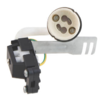That extract from BS7671 surely relates to "each point in wiring and at each accessory" of the electrical installation, and not to an item of Class II equipment fed by the installation, doesn't it?
It states except for suspended lamp holder, so it is quite plain if not suspended i.e. fixed to the ceiling it includes it. You know as well as I do the rules changed in 1966, up to then you did not need an earth to the lights.
There are a few rules where people seem to want to debate meaning the reference to
Purpose. Single-core cables that are coloured green-and-yellow ~
seems people miss the full stop.
(iv) reduce the possibility of unwanted tripping of RCD's due to excessive protective conductor currents produced
by equipment in normal operation
I would have said that means twin RCD's do not comply in most cases, except for very small homes, yet we see twin RCD consumer units being the norm.
As to if designed so people could wangle out of it I don't know, what I would say we are worried about is rental accommodation and some pedantic jobs worth awarding a code C2. I know I have bent the rules, and I am sure you have, however if some one calls an electrician to do some work, and that electrician says sorry I need to tread in some new cables to include the earth, we can't say he is wrong.
I will admit I am not sure about a tank thermostat with the green/yellow over sleeved, since on flex, and held to the tank with a spring around the tank, is the cable part of the in service electrical equipment or part of the installation. The former can be class II, the latter needs an earth.
So use of plug in ceiling roses,

and loose panels in a suspended ceiling which is common, are those panels in service electrical equipment in the same way as a class II table lamp? If so then no need for an earth from plug to lamp.
We seem to see the FCU in the same light as a plug and socket, so we are happy to connect a class II item to them.
So if we had again a suspended ceiling and standard ceiling roses and twin core going to a GU10 lamp in the panel I would again consider the panel/lamp combination as electrical equipment.
However in plaster board it is installed, not simply placed there, so I will let you explain the 1966 rule change and say how you read the regulations.




